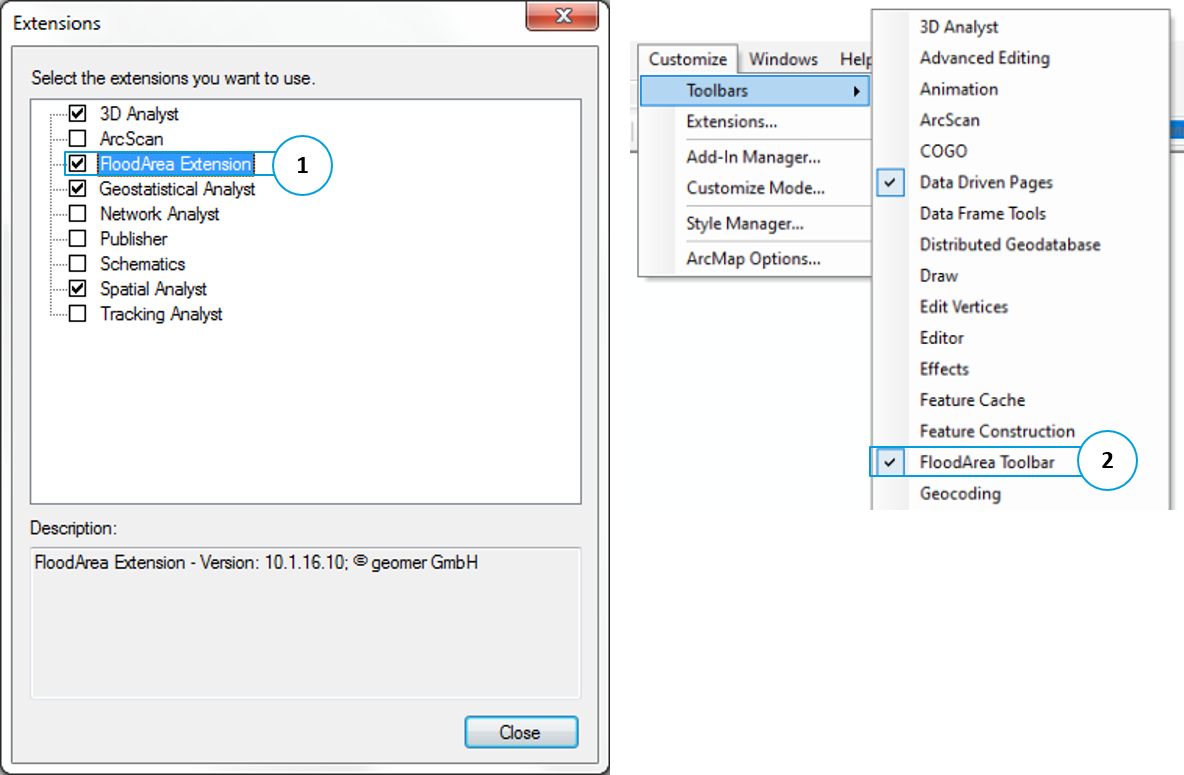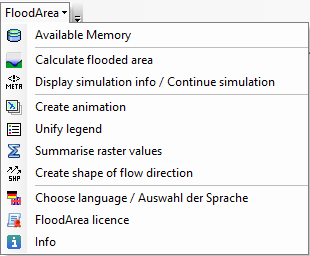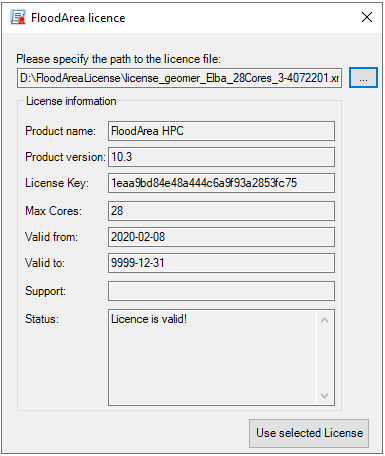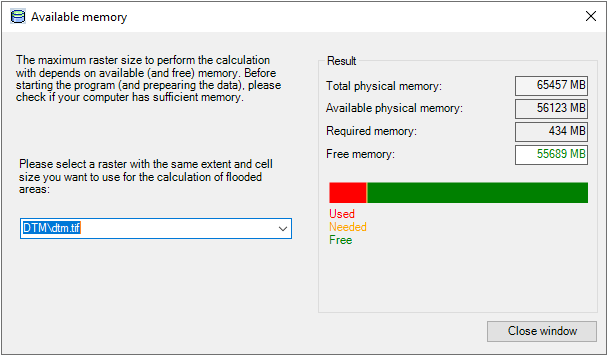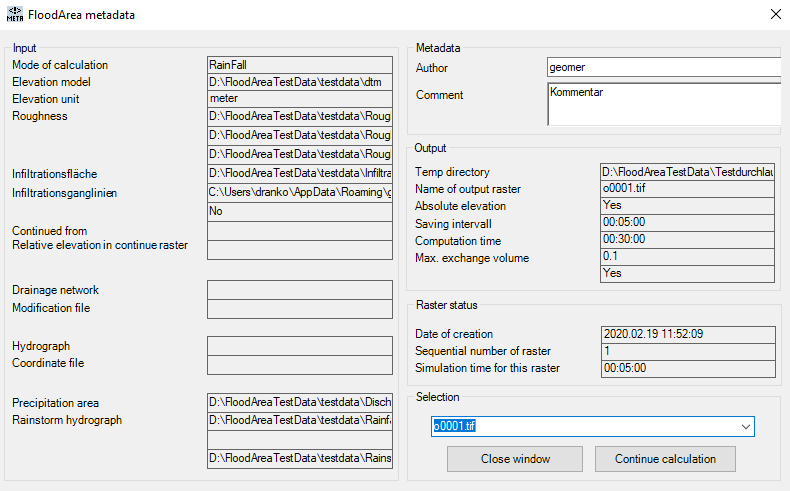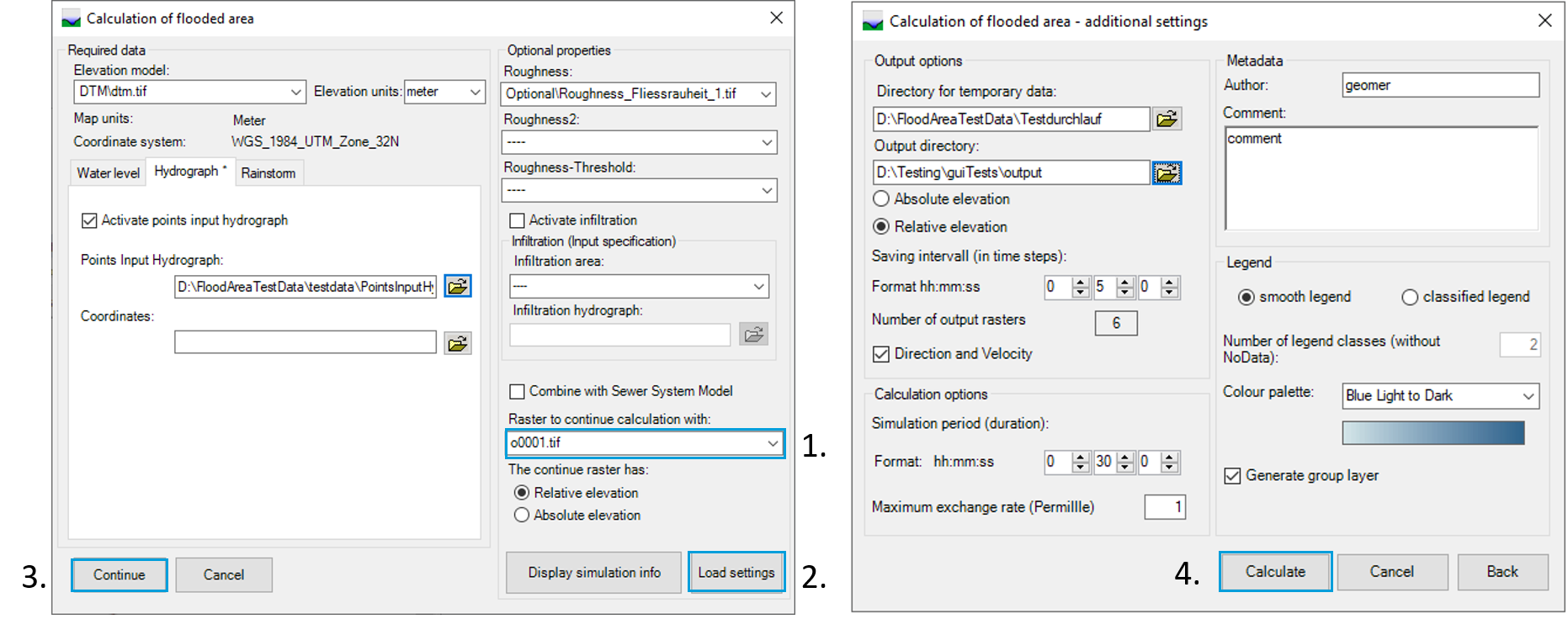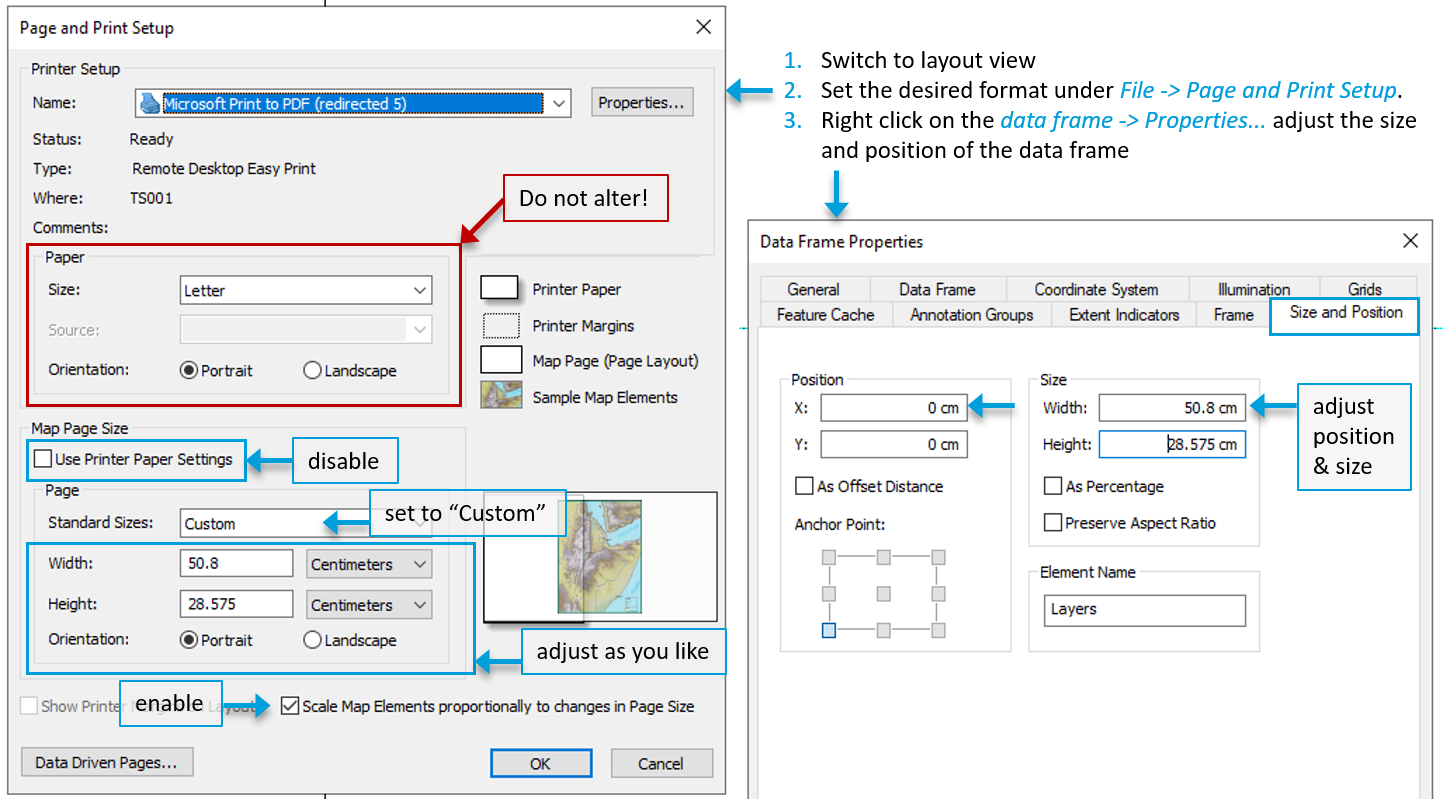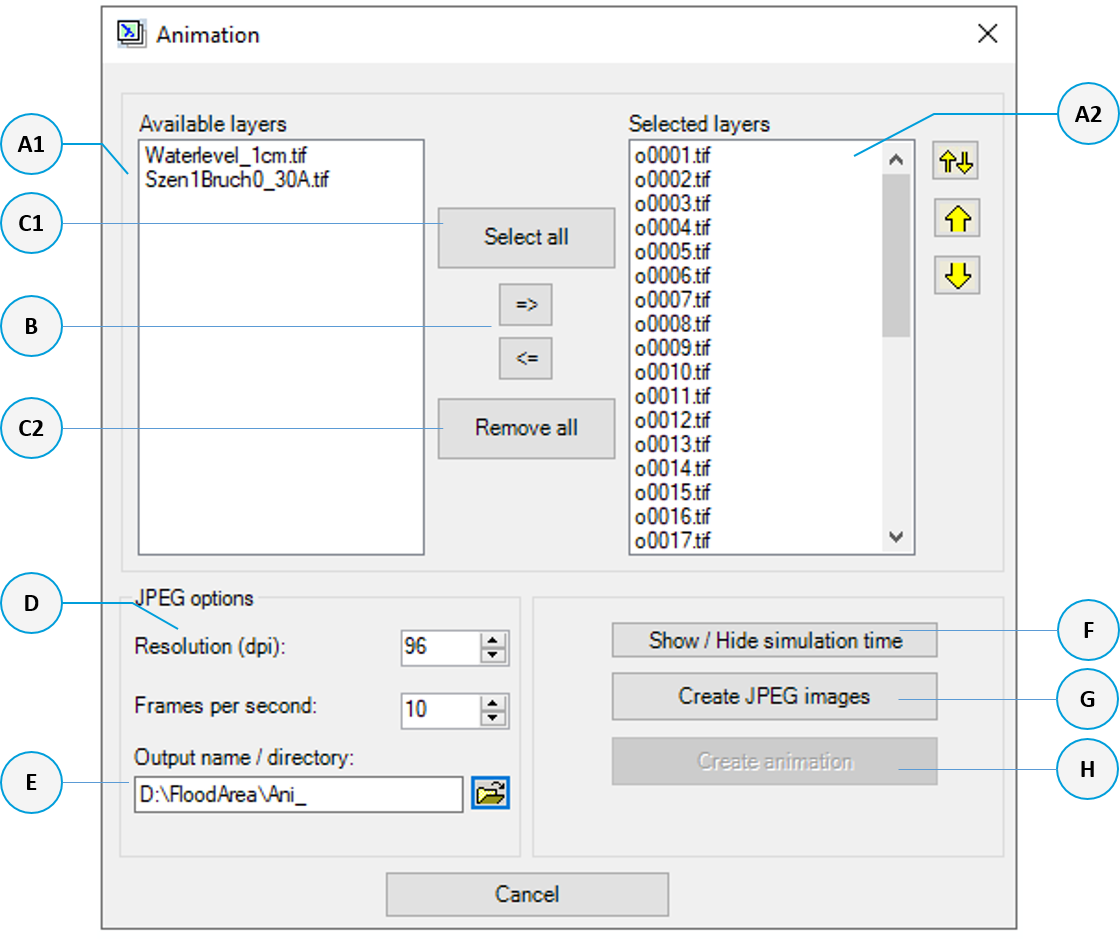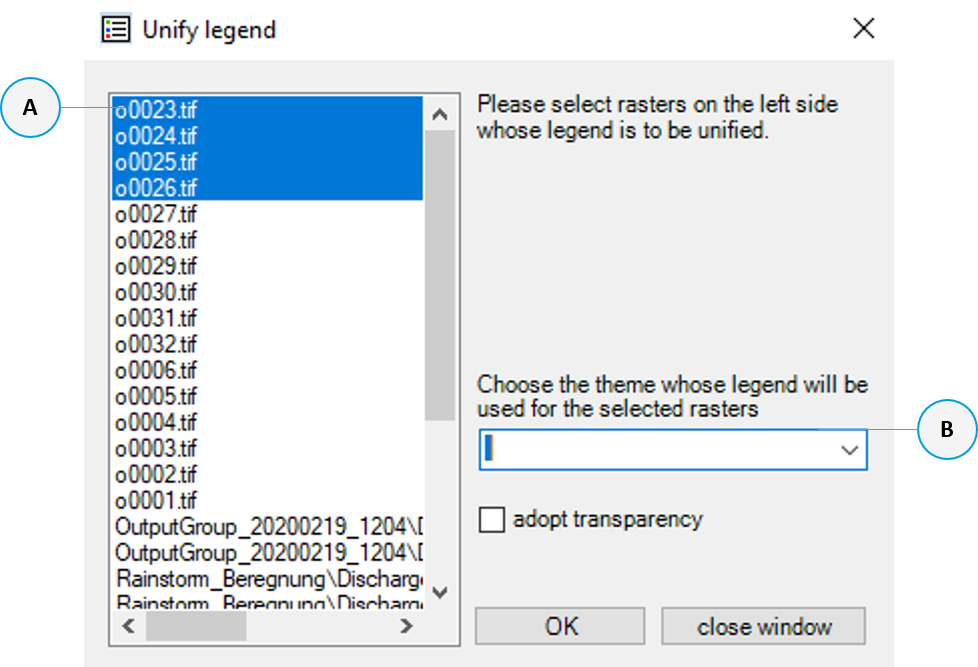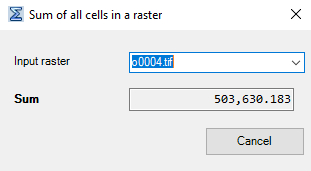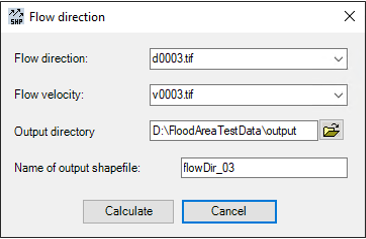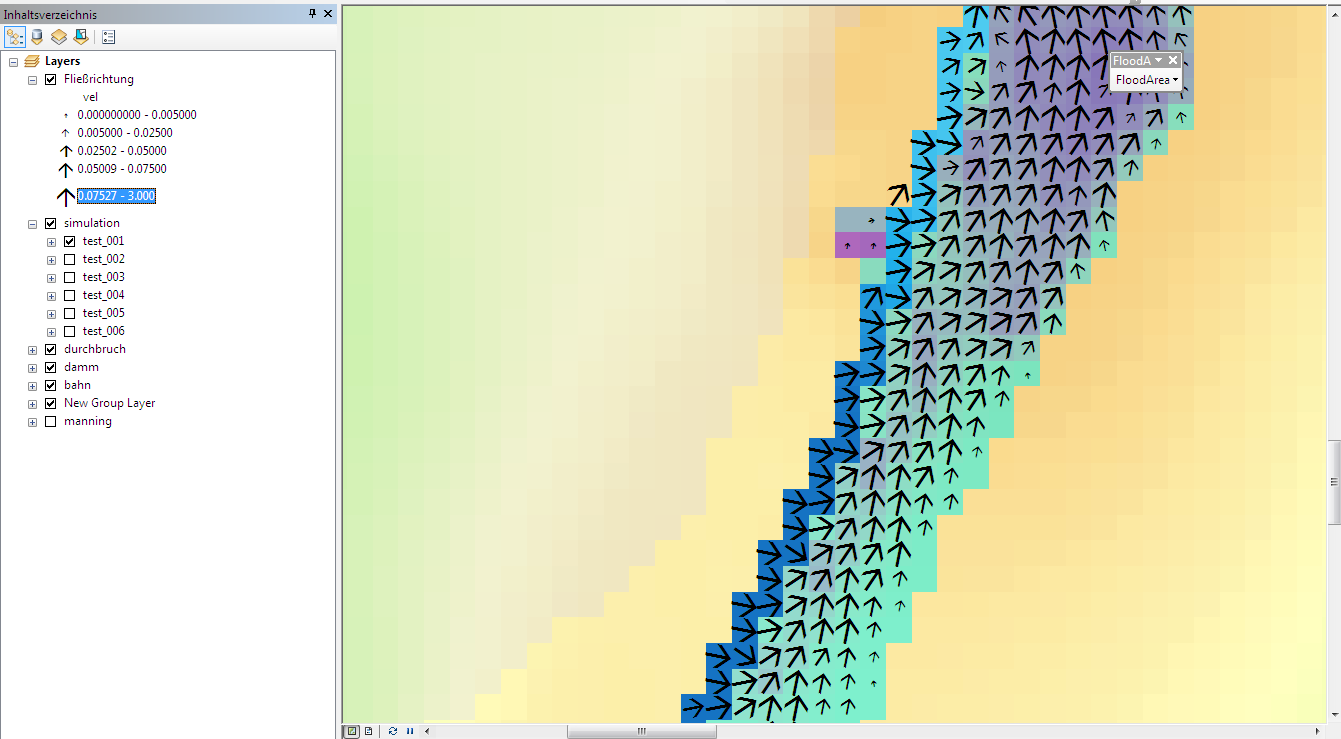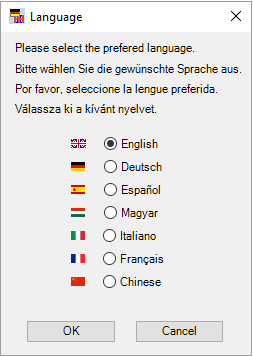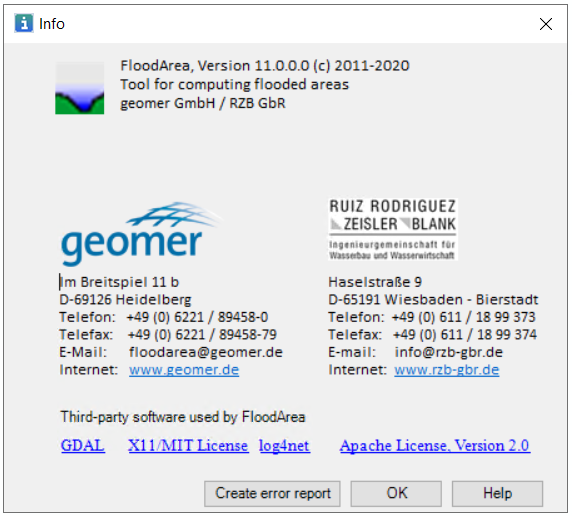GUI¶
Activation¶
After installation and activation of the extension, a new toolbar is permanently available in ArcMap. Before you can use it, you must activate it by clicking the box in the Customize menu ( Extensions and Toolbars).
After loading the toolbar, this toolbar is available like all others. The available sub-items are shown in the following figure.
FloodArea License¶
Here the license for the FloodArea extension is either displayed, specified or changed.
As long as „DEMO“ is displayed as license number, FloodArea works in demo mode, so all results are watermarked. In oder to leave the demo mode, you need a valid license file and a USB dongle.
The required license key is delivered as xml-file and can be copied to any place. If the dongle is activated (see Installation and License), the license file must be specified in the FloodArea toolbar to use the full functionality of FloodArea in ArcMap. You can access the corresponding dialog by selecting the item FloodArea License from the FloodArea menu.
After entering a valid license key file for FloodArea, the full functionality is available.
Available working memory¶
This menu item can be used to check whether the required working memory is also available. Please note that this can only be an estimation, since all other programs and the operating system also permanently access the available memory. The memory specifications only include the physical memory, since the virtual memory is not recommended to be used if possible. You have the option of specifying a raster layer from the current data frame or a raster data set available on the hard disk. If you select the option Load from disk, the selected raster is then also loaded into the data frame.
Calculation of flooded areas¶
This menu item represents the core of FloodArea HPC 11. The menu item Calculate FloodAreas leads to the following dialog box:
The preconditions of the simulation are explained in the chapter Input data. The input of a terrain model and the selection of the height unit is mandatory. All other calculation options can be freely selected.
The calculation option to be used must be selected by checking the Activate….option. The activated options are marked with a ‚*‘. One of the three calculation options Water level, Hydrograph or Rainstorm must be active. All three calculation options can be combined as desired. Only the optional functions Roughness or Calculation Grid do not need to be activated separately.
The data formats and specifications of the calculation options are explained in the respective chapter (Water level - Point injection - Irrigation - Optional functions).
The data can either be taken from the list of loaded raster layers or from disk.
Additional Settings¶
Before the user can continue, the program checks the entries for plausibility. If there are any discrepancies, the user is notified of any problems or is asked to provide additional information. The check is carried out, for example, with regard to missing or incorrect entries. The button is only activated again when the plausibility is established.
Field A an B:
Working directories for temporary data that are generated at the beginning of the simulation and the output data. In the output folder another folder named „output“ is automatically created, in which the result grids are stored. The result grids of the flood calculation itself are named after the pattern o + four-digit number (o0001.tif, o0002.tif etc.). If the selected grids do not already exist, they are created automatically.
Field C:
The output units of the calculation results can be in water level (absolute heights, usually this is the height above sea level) or in relative heights (flood depths). The units correspond to those of the terrain model entered.
Field D:
Furthermore the storage interval can be specified. The smallest time unit is one second.
Field E:
Checking the box for flow direction and flow velocity, grid data necessary for the creation of flow direction shapes are generated. Please note that this option generates three grids instead of one per calculation step. Especially when using this option, you should make sure that there is enough disk space available (in other cases, of course, as well). The additionally created rasters are stored in the output folder in separate folders named „velocity“ and „direction“. The file names will start with „v“ or a „d“.
Field F:
Under the item Calculation options the total calculation duration can be entered. If a simulation is to be continued, the duration is extended by the value entered here.
Field G:
The Maximum exchange rate specifies the maximum amount of the current cell content that can be passed on to the neighboring cells during one iteration step (in promille). The value specified here indirectly influences the simulation speed, since the model reduces the duration of the iteration interval in order to fulfill this condition. If the values specified here are relatively large, a „ripple“ can occur in the model depending on the environmental conditions. These instabilities do not lead to a termination of the simulation run, but in extreme cases they can lead to an interruption of the simulation run, since too high water levels in individual cells falsify the results. Experience shows that values between 1 and 5 give the best results. The smallest possible input value is 1 (corresponds to 0.1%). Larger exchange quantities (a maximum of 100 (10%) is possible) are only useful, if you want to shorten the simulation time significantly in the sense of a preview. For this purpose, it is advisable to calculate with a coarser grid.
Field H:
FloodArea uses the Metadata concept of ArcGIS to store information about the rasters created during the simulation. Some of this information is generated automatically (like the simulation duration), others can be entered here like an author or scenario information etc.
Field I und J:
Here you can define the Legends for the output grid layers according to the ArcMap options. The value for NODATA is set to transparent by default. You can choose between a smooth legend or a classified legend and define a number of legend classes. The color ramp selection list also provides the option to load own color ramps. All generated raster layers receive the same display symbols. Finally, the Generate group layer option can be activated to add the calculated result grids as a group to the list of loaded raster layers. The group gets the name of the output grid followed by „Group“.
Use Calculate (J) to save the settings and start the calculation. Pressing the Cancel button discards the new entries.
Calculation process¶
During the simulation, a window opens that shows the progress of the simulation. As this window is opened in the foreground during simulation, the ArcMap window cannot be used.
If ArcMap is closed during the simulation, the FloodArea simulation will also be quit. In this case, the simulation can be restarted using the FloodDepth Grid that was written out last - see option Continue Calculation.
The simulation settings are written to the specified temp folder in the file fng.xml.
A backup is written to the specified output folder during simulation. The frequency of the backup intervalls can not be set in the GUI. The backup is written every four hours (processing time). A log file is also written to the output folder.
Display creation info¶
Under this item, the creation information (FloodArea metadata) can be displayed and calculations that have been started can be continued.
For the continuation of an aborted simulation you can either load a flood depth grid layer from the current map frame or a flood depth grid stored on your hard disk.
The simulation parameters used to generate the respective grid are listed in the input section. The output section shows the simulation parameters which were specified during the simulation. If during the simulation in the main menu or under More settings a checkbox was activated, the value Yes is entered here. If this is not the case, the value No appears. Not all switches are listed here, but their status can be derived from the ones given.
Close window terminates the display of metadata and returns to ArcMap. With the button „continue calculation“ you can switch to the main dialog (see below). The grid used for further calculation is automatically entered into the dialog.
The button Load settings in the main menu reads the settings from the metadata of the selected grid and writes them into the flood simulation dialog. Otherwise, the settings of the last calculation or already specified data are used. On the other hand, the settings of the More Settings dialog are always automatically applied when a further calculation grid is specified, so that, for example, the same legend and the same saving interval are selected. If a change of the respective settings is desired, these must be made accordingly.
Create Animation¶
With the help of the functions under the menu item Animation, the temporal course of a flood can be visualized better than it is normally possible with ArcMap. A series of JPEG images and an animation file in MP4-format can be generated.
First of all, the inundation depths with which an animation is to be created and desired background maps are loaded into a new ArcMap document. Via the tool Assign same legend you can adjust the legends of the flooding depths. The next step is to switch to the layout view and set your format as desired under File - Page and Print Setup… . The procedure is shown in the following illustration.
You can insert legends, north arrows or other map elements into your layout as you wish, pan to the desired map section and adjust the scale. When the layout is ready, open the animation tool.
The layers to be included in the animation are managed in lists A1 and A2. From the list of available layers (A1), individual layers (via the switch B) or all layers at once (via the switch C1) can be selected.
Accordingly, the layers can also be removed from the list of selected layers individually (switch B) or as a whole (switch C2).
In both lists, a selection of several layers is possible. By holding down the Ctrl or Shift key, you can select one or more layers.
In the list on the right hand side, you can modify the sequence of the screens to be generated by arranging the layers in the appropriate order.
The buttons  and
and  move selected layers up and down in the list. Pressing the
move selected layers up and down in the list. Pressing the  button
reverses the entire sequence of the layers. You can select and reorder all layer at once as well.
button
reverses the entire sequence of the layers. You can select and reorder all layer at once as well.
The list of FloodArea layers appears in reversed order compared to the arrangement in the legend of ArcMap.
This is because the last layers drawn in ArcMap must also be exported last when the animation is created.
Reverse the order via the button  !
The list is processed from top to bottom, while the table of contents of ArcMap is drawn from bottom to top.
!
The list is processed from top to bottom, while the table of contents of ArcMap is drawn from bottom to top.
remark
You can deactivate and group the flooding depths in the table of contents. It is only important that the group is activated. The background maps or hillshades should be activated.
In the input fields D the quality of the generated JPEG images and animation is defined. A lower JPEG quality reduces the size of the generated images and animations. The Frames per second input fields define the playback speed of the generated MP4-file. In the input field E the directory in which the generated images/movies are stored and the names of the files to be generated are defined. With input field F the simulation time of each FloodArea raster layer in the image/movie, read from the metadata, can be optionally displayed or hidden.
As soon as an output name has been entered, the simulation time can be displayed (input field F). This is read from the metadata of the inundation depths and appears at the bottom left of the layout when the field is activated. The format and location of the simulation time can be adjusted manually! To do this, you have to close the animation tool (via the Cancel button) after you have activated the simulation time. Now you can click on the simulation time and move it. In order to adjust the font, size and colour, do right click -> Properties… -> Change symbol (as with other text elements). Then open the animation tool again and continue (you have to set the fields D and E again).
Next, use the Switch G to create the JPEG images. The same number of images will be created as the number of result grids in the list of selected layers. The creation of an animation file can only be started after the JPEG images have been generated by the switch H. It is important that after the JPEGs have been created, the animation tool is NOT closed again, but the animation file is created directly! Otherwise the tool will not find the JPEGs again and they have to be created again.
If the animation file has been created successfully (it is located in the specified directory), the animation tool can be closed.
Unify legend¶
This menu item provides a tool to assign an identical legend to different raster layers. This is especially necessary, if you want to compare results from different calculation runs.
First select all layers in the List A which should get the same legend. Then select a layer that already has the desired legend display in the selection list B. Choose OK to accept the selection and all selected layers are displayed with the same legend.
Sum of all cells in a raster¶
This function adds up all cell values of a raster layer. If, for example, flood depths exist and horizontal and vertical units are identical, the existing total water volume is output. This allows the analysis volume balances.
Create flow direction shape¶
A shape file can be generated with flow direction information. Herefore the grids are used, that were calculated when the option Direction and Velocity was activated in the Additional settings dialog. To do this, the corresponding grids must be selected and a name for the output must be specified. The files are located in the same directory as the output files with the water levels. Please note that the required input files will only be created if this has been set under Addtional settings.
If the direction arrows are displayed too large or small, this may be due to a missing or the incorrect entry of map units and the reference scale in the map frame properties.
In other cases you should use the advanced options of the legend to adjust the reference scale. The default scale is 1:1000. This scaling is optimized for the provided demo area.
According to the internal management of the neighbouring grid cells, it is possible to display 16 different directions. This results in a relatively uniform flow pattern. However, it should be noted that the flow direction specifications are snapshots of the entire sumulation time. It is therefore wise to display several situations, especially in situations with strongly changing flow conditions.
Language¶
FloodArea contains the option to change the language of the dialog boxes, help texts and messages between German, English, Hungarian and Spanish. After pressing the OK button, the working environment of FloodArea is immediately changed to the selected language. This does not apply to the language of the ArcMap interface.
Info¶
The version number and service addresses are displayed here. This dialogue also includes the Help button, by clicking this button will open user manual.
